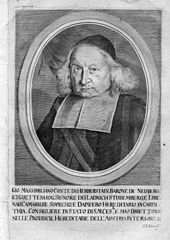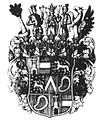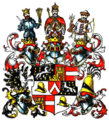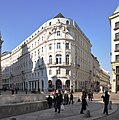Herberstein (noble family)

Herberstein is the name of a former noble family , which has been traceable in Eastern Styria since 1287 and which continues to grow and grow. a. branched out to Silesia . From 1290 it was named after its ancestral seat, the Veste Herberstein . In 1537 the family was made imperial barons , in 1644 as hereditary-Austrian counts and in 1710 as imperial counts .
history
The Styrian line goes back to the progenitor Otto von Aflenz (*?; † 1340), who also called himself " von Hartberg ". The family first appeared in a document on December 6, 1290, when the knight Otto von Hartberg acquired the Herberstein fortress and named himself after it. With him the safe line of the family begins. In 1537 the Herbersteiners rose to the status of imperial barons . In 1644 they obtained the title of Herbländisch-Austrian Count and in 1710 were elevated to the rank of Imperial Count.
The Herbersteiners began their centuries of service in the Habsburg lands as fiefdoms of princely goods. Almost 400 male bearers of the name are known. They provided five governors of Styria , officers of all degrees up to field marshal , diplomats, civil servants, courtiers and a minister of state as well as clergy and bishops. The representatives of the family also include mathematicians and professors of philosophy, grammar and world history.
Targeted expansion of ownership and favorable marriage connections in the 14th and 15th centuries contributed to the increasing consolidation of their position. Among other things, the marriage of Count Leopold von Herberstein to Eleonore von Eggenberg brought the most important palace complex in Styria, the Eggenberg Palace in Graz, into the possession of the family.
After the head of the Styrian line, Count Johann Maximilian von Herberstein, died in Vienna in 1935 after a childless marriage and the estate was not negotiated until 1937, his brother Count Johann Herbert managed the inheritance and took over the Herberstein, Neuberg and Eggenberg lordships and their families Lands. Fully occupied with the administration of the state's own goods, in 1939, shortly before the start of the war, the Eggenberg Palace was sold to the State of Styria. Johann Maximilian had adopted his nephew Johann Otto (1897–1938) and made it the main heir of the Herberstein-Eggenberg estates. After Johann Otto's early death at the age of 41, his eldest son of the same name, Johann Otto (1937–1994), inherited the property at the age of one.
On the initiative of his second young wife Andrea, the renovation of the buildings of the Herberstein Castle began in the mid-1970s. The decisive help in this was the state exhibition held in the castle in 1986 " The Styria Bridge and Bulwark ". As a result, the zoo was also expanded into a tourist attraction. In 1987 there was a divorce, which resulted in a veritable flood of litigation ( Causa Herberstein ). In 1993 Johann Otto Herberstein married for the third time, but died the following year. Herberstein's youngest daughter Felicitas inherited everything according to a will from 1988, but shared her fortune equally with her two siblings Catherine and Maximilian. Herberstein OEG was subsequently founded and Maximilian (born 1977) became its managing director.
The Herberstein headquarters remained in the family's possession for over 700 years. The rulership of the same name was one of the largest in Styria.
In 1728 the Silesian line of the Herberstein family died out (see below) and their majority rule Grafenort (in the County of Glatz) fell to the Styrian line by will.
In 1849, Count Friedrich von Herberstein and Proskau, governor of Styria, married Theresia von Dietrichstein (1822–1909). When their father, Prince Josef von Dietrichstein zu Nikolsburg (1798-1858) died, she inherited the Bohemian Fideikommiss Budin and Libochowitz , which also included Nepomyšl , Slatina and Wällisch Birken , according to the family contract . Their descendants remained owners until 1945 and the subsequent nationalization in favor of Czechoslovakia .
Personalities of the Styrian line
- Günther von Herberstein (*?; † 1421), castle captain of Graz, field captain of Styria
-
Bernhardin I von Herberstein Baron of Neuberg and Gutenhag (* c. 1490; † 1554), provincial administrator of the Duchy of Styria, colonel of the Styrian people of war. His son:
-
Georg der Breite von Herberstein Imperial Baron of Neuberg and Gutenhag (* 1529; † 1586), 1570 provincial administrator, 1580 provincial governor of Styria. His son:
-
Bernhardin II. Von Herberstein Imperial Baron zu Neuberg and Gutenhag, (* 1566; † 1624), Imperial Supreme Court Marshal. His son:
-
Johann Maximilian I von Herberstein , since 1644 Imperial Count von Herberstein Freiherr zu Neuberg and Gutenhag (* 1601, † 1680), Governor of Styria. His sons (all Counts von Herberstein Barons zu Neuberg and Gutenhag):
- Johann Ferdinand I. Graf von Herberstein (* 1640; † 1675), major general. Whose sons:
- Johann Georg Graf von Herberstein (* 1660; † 1686), officer, fell during the storming of Buda (closer progenitor of the line)
- Johann Ferdinand II. Count von Herberstein (* 1663; † 1721), Knight of the Order of Malta, Lieutenant Field Marshal, Vice President of the Inner Austrian Court War Council, Großbailli of the German Tongue of the Order of Malta (1709 to 1711)
- Johann Otto Graf von Herberstein (* 1666; † 1700), Field Marshal Lieutenant, (male offspring died out with his son)
- Johann Ernst Graf von Herberstein (* 1671; † 1748), kk Real Privy Councilor, Provincial Administrator in Styria: the male offspring died out with his sons
- Johann Ernst Graf von Herberstein (* 1709; † 1778), Majorate Lord of Gutenhag.
- Johann Joseph Graf von Herberstein (* 1715; † 1760), Knight of the Teutonic Order, Commander in Friesach, Field Marshal Lieutenant.
- Johann Karl Graf von Herberstein (* 1719; † 1787), Bishop of Laibach (1722–1787), supported the reforms of Emperor Josef II.
- Johann Joseph Graf von Herberstein (*?; † 1692), Knight of the Order of Malta, Grand Prior of the Order of Malta in Hungary, later Commanding General in Croatia, Slavonia and the Austrian sea coasts and General Feldzeugmeister,
- Johann Maximilian II. "The younger" Count von Herberstein (*?; † 1679), Governor of Carinthia, from 1675 Governor of Styria (left no sons)
- Johann Ferdinand I. Graf von Herberstein (* 1640; † 1675), major general. Whose sons:
- Johann Ferdinand Graf von Herberstein (* 1605; † 1673), Jesuit, professor for dialectics, ethics, scholasticism and canon law in Graz, Judenburg and Linz
-
Johann Maximilian I von Herberstein , since 1644 Imperial Count von Herberstein Freiherr zu Neuberg and Gutenhag (* 1601, † 1680), Governor of Styria. His sons (all Counts von Herberstein Barons zu Neuberg and Gutenhag):
-
Bernhardin II. Von Herberstein Imperial Baron zu Neuberg and Gutenhag, (* 1566; † 1624), Imperial Supreme Court Marshal. His son:
-
Georg der Breite von Herberstein Imperial Baron of Neuberg and Gutenhag (* 1529; † 1586), 1570 provincial administrator, 1580 provincial governor of Styria. His son:
- Siegmund von Herberstein (* 1486; † 1566), Austrian imperial councilor and envoy to the Russian court
- Caspar von Herberstein (*?; † 1572), field captain and chief steward
- Leopold von Herberstein (*?; † 1606), Field Marshal General, Commander in Chief, President of the Court War Council
- Adam von Herberstein (* 1577; † 1626), Austrian treasurer Archduke Matthias, later emperor; imperial envoy to Constantinople
- Johann Georg von Herberstein (* 1591; † 1663), Bishop of Regensburg
- Georg Sigmund von Herberstein (* 1594, † 1663), Reichshofrat, Obersthofmeister, Imperial envoy in Paris; joined the Dominican order in 1631, of which he became provincial, 1655 mayor of the city of Engen → St. Wolfgang Monastery (Engen)
- Sigismund Christoph von Herberstein (* 1644; † 1716), Bishop of Laibach
- Maximilian von Herberstein (* 1609; † 1688), General of the Republic of Venice. Whose sons:
- Ernst Gundakar von Herberstein (* 1654, † 1723), Lieutenant General Field Marshal and Court War Councilor
- Matthias Gundakar von Herberstein (* 1658; † 1737), electoral secret councilor; Chief Justice of Leipzig
- Ferdinand Ernst von Herberstein (*?; † 1691), Field Sergeant and Court War Councilor
- Ferdinand Ehrenreich von Herberstein (*; † 1692), Reichshofrat
- Ferdinand Ernst Karl von Herberstein (*; † 1720), mathematician; Land rights assessor in Bohemia
- Carl Leopold von Herberstein (*; † 1726), Lieutenant General Field Marshal and Court War Councilor, Knight of Malta, Grand Bailli (1703 to 1709) and Grand Prior of Bohemia, Austria and Silesia (1721 to 1726)
- Leopold von Herberstein (* 1655; † 1728), adjutant to Prince Eugene; Field Marshal General and President of the Court War Council
- Ferdinand Leopold von Herberstein (* 1695, † 1744), envoy in Stockholm, later chief steward and minister of state. Whose sons:
- Anton Johann Nepomuk von Herberstein (* 1725; † 1774), Prince-Bishop of Trieste
- Karl Wenzel von Herberstein (* 1729; † 1798), envoy of the Order of Malta in Vienna, field marshal lieutenant
- Ernest Johann Nepomuk von Herberstein (* 1731; † 1788), first bishop of the Diocese of Linz
- Johann Seyfried von Herberstein (* 1706; † 1771), President of the Court Chamber, President of the Commercial Directorate in Trieste
- Johann Leopold von Herberstein (* 1712; † 1789), Governor of Styria
- Johann Karl von Herberstein (* 1719; † 1787), Bishop of Laibach
- Joseph von Herberstein (* 1757; † 1816), finance scientist, Vice President of the Court Chamber
- Johann Siegmund zu Herberstein (* 1831, † 1907), Freiherr zu Neuberg and Gutenhag, Colonel Hereditary Treasurer and Truchsess in the Duchy of Carinthia, hereditary member of the manor of the Austrian Imperial Council
- Johann Herbert von Herberstein (* 1863; † 1940), Lieutenant Field Marshal and Chief Steward of Archduke Friedrich
Personalities of the Silesian Lines
Around 1600 Baron Johann Bernhard the Elder founded Ä. von Herberstein († 1665) the Silesian and Glatzer line of Herbersteiner. He was Imperial Chamber Councilor, Chamberlain and Hereditary Treasurer of Carinthia and married to the Silesian baron Juliana Kunigunde von Tschentschau-Mettich († 1645). The couple's sons were:
- Johann Friedrich the Elder Ä. (1626–1701), came to the great Lordship of Grafenort in the county of Glatz through marriage in 1651 . With the permission of the ruler, he built out of his reign Grafenort, which remained until 1930 in the possession of Herber Steiner, a primogeniture .
- Johann Georg Bernhard Freiherr von Herberstein (born April 21, 1627 in Neisse , † April 18, 1649 in Rome), was a canon of Breslau.
- Johann Bernhard II. Von Herberstein (also: Johann Bernhard the Younger von Herberstein ; 1630–1685), since 1671 governor of Breslau and Glogau . In 1680 he donated the stucco decoration of the nave ceiling and the vault with a Herberstein family coat of arms on the triumphal arch for the parish church Corpus Christi in Brieg bei Glogau ( Brzeg Głogowski ). At the same place he built a baroque palace from 1671 to 1685 on the site of an earlier manor house. Both works were created according to plans by the builder Carlo Lurago .
Sons of Johann Friedrich von Herberstein the Elder Ä .:
- Johann Friedrich Erdmann von Herberstein (also: Johann Friedrich the Younger ) (1658–1712) stayed 1678–1683 for studies in Italy. After his return he married Maria Carolina von Zierotin († 1719). Inherited the majority rule Grafenort from his father. From 1696 to 1707 he was governor of the County of Glatz.
- Johann Leopold Erdmann von Herberstein (1659–1728) was Silesian chamber councilor until 1713. His first marriage was to Maria Theresia von Althann († 1703), daughter of Michael Wenzel von Althann and Anna Maria von Aspremont, and the second to Maria Rosalia Countess von Jörger , daughter of the Lower Austrian governor Johann Quintin von Jörger. In 1701 he inherited the allodial estates Schnellendorf, Wangern and others in Silesia from his father and, after the death of his nephew Johann Anton von Herberstein in 1720, the majority rule Grafenort.
- Johann Anton von Herberstein, the only son of Johann Friedrich the Elder. J., was married to Countess Maria Antonia von Liechtenstein. After the death of his father he inherited the majority rule Grafenort in 1712 and the estate ( castle courtyard ) in Rengersdorf from his mother in 1719 . After he died on July 6, 1720 in Prague without heirs, his widow inherited the Rengersdorf allodial estate. The majority rule Grafenort fell to the next agnate , Johann Leopold von Herberstein auf Wangern († 1728), his father's brother (see above).
After Johann Leopold died without descendants in 1728, the majority rule Grafenort fell to the Styrian line of Herberstein in his will:
- Johann Gundacker I von Herberstein was presumably a son of Field Marshal General Ernst Gundakar von Herberstein, who died in 1723 (see above), so that Johann Gundacker was the next agnate to whom the Grafenort majority rule came in 1728. Since he was not yet of legal age, he was initially under the guardianship of his mother Maria Josefa nee Breuner. From 1735 he managed his estates himself. Was married to Marianna NN; died in 1770. He was followed by his son of the same name:
- Johann Gundacker II of Herberstein († 1810). In 1770 he inherited the majority rule of Grafenort, on which he established the colonies of Hayn and Hüttengrund . Was married to Antonia von Schrattenbach . After her death in 1778 he married Countess von Stargk. Nine years before his death, he handed over the majority rule of Grafenort to his only son:
- Johann Hieronymus von Herberstein was born in Grafenort in 1772, received the majority rule Grafenort from his father Johann Gundacker II in 1801 and was married to Henriette Countess von Salm-Kyrburg. In 1816 he founded the Grafenort Castle Theater. He died in Grafenort in 1847.
coat of arms
Blazon : The Count's coat of arms of the Herberstein family is split and divided twice, as a crowned heart shield, the family coat of arms with a silver rafter on a red background; Fields 1 and 4 show a silver wolf sprinkled with silver hearts on a black background (coat of arms of the Lords of Neidberg ) ; Fields 2 and 5 show a golden, crenellated round tower on a red background at the front, a silver bar on a red background at the rear; Fields 3 and 6 a golden, lying horse collar on a red background.
Coat of arms history: According to the tradition handed down by Siegmund von Herberstein, the rafter symbolizes the plow loop and is a reminder of the first Herbersteiners who tilled their land as farmers. Fields 2 and 5 show the combined royal-Castilian and Archduke-Austrian coats of arms, which Emperor Charles V added to the family coat of arms . Fields 3 and 6 show the coat of arms of the Hag family on Gutenhag. Anna, daughter of the last Hag, married Heinrich von Herberstein in 1379. In the course of time, the horse collar has been transformed into a hat in some depictions. The coat of arms is decorated with half-length portraits of the emperor, the king of Spain and the Russian tsar.
- Family coat of arms, baron's coat of arms and count's coat of arms
Herberstein family coat of arms, Stein im Florentinerhof, Herberstein Castle
Baron coat of arms of those von Herberstein, according to Johann Siebmacher's coat of arms book 1605
Bay window in Linz , Losensteiner Freihaus (Altstadt 2): optically on the right, barons coat of arms for those of Herberstein, optically on the left, coat of arms for those of Losenstein
Increased coat of arms of the Counts of Herberstein, probably 17th century.
Increased coat of arms of the Counts of Herberstein, according to Tyroff AT, between 1831 and 1868
Increased coat of arms of the Counts of Herberstein, around 1901
Possessions
The Herberstein family in Austria owns Herberstein Castle , Styria (since 1290 until today), and Kirchberg an der Raab Castle (since the end of the 20th century). Former properties are the Eggenberg Palace (Graz) (1717–1938), the Herberstein Palace (Graz) (1742–1939) and the Herberstein Palace (Vienna) (1896–1951).
- Present and former property in Austria
Herberstein Castle, Styria (since 1290 until today)
Kirchberg Castle on the Raab (since the 20th century)
Herberstein Palace , Vienna (1896–1951)
Eggenberg Palace (Graz) (1717–1938)
Herberstein Palace (Graz, Sackstrasse) (1742–1939)
The Herberstein family in Bohemia and Silesia once owned the lordships of Grafenort , Grafschaft Glatz (1651–1930), Triesch (1626–1657), Goltschjenikau (1817–1830), Budin an der Eger (1858–1945), Libochowitz (1858–1945) ), Nepomyšl (1848–1945), Slatina (1858–1945), Wällisch Birken (1858–1945), Groß Opatowitz (? –1934) and Welkan .
- Former property in Bohemia and Silesia
Grafenort Castle , County Glatz (1651–1930)
Budin Castle on the Eger (1858–1945)
Libochowitz Castle (1858–1945)
Nepomyšl Castle (1848–1945)
Wällisch Birken Castle (1858–1945)
literature
- Constantin von Wurzbach : Herberstein, the house, genealogy . In: Biographisches Lexikon des Kaiserthums Oesterreich . 8th part. Kaiserlich-Königliche Hof- und Staatsdruckerei, Vienna 1862, pp. 325–329 ( digitized version ).
- Constantin von Wurzbach : Herberstein, the house, coat of arms . In: Biographisches Lexikon des Kaiserthums Oesterreich . 8th part. Imperial-Royal Court and State Printing Office, Vienna 1862, p. 344 ( digitized version ).
- Valentin Einplayer: Herberstein. In: New German Biography (NDB). Volume 8, Duncker & Humblot, Berlin 1969, ISBN 3-428-00189-3 , p. 577 f. ( Digitized version ). (Family item)
- Genealogisches Handbuch des Adels , Adelslexikon Volume V, Volume 84 of the complete series, pp. 133-135, CA Starke Verlag , Limburg (Lahn) 1984, ISSN 0435-2408
- Joachim Bahlcke , Winfried Eberhard, Miloslav Polívka (eds.): Handbook of historical places . Volume: Bohemia and Moravia (= Kröner's pocket edition . Volume 329). Kröner, Stuttgart 1998, ISBN 3-520-32901-8 .
- Joseph Kögler : The chronicles of the county Glatz . Revised by Dieter Pohl . Vol. 4, ISBN 3-927830-18-6 , pp. 285-288.
- Arno Herzig , Małgorzata Ruchniewicz : History of the Glatzer Land . Hamburg-Wrocław 2006, ISBN 3-934632-12-2 .
Web links
- Family history Herberstein ( Memento from August 15, 2010 in the Internet Archive )
- Pedigree of Johann Josef Karl Heinrich Graf zu Herberstein 1878 at monasterium.net
Individual evidence
- ↑ Joseph August Kumar: History of the castle and the Herberstein family. Vienna 1816–1817 and Hans Pirchegger: The Beginnings of the Herberstein House. In: Blätter für Heimatkunde. 10, Graz 1932, p. 6 ff.
- ↑ Roman von Procházka : Genealogical handbook of extinct Bohemian noble families , supplementary volume, edited by the board of the Collegium Carolinum (Institute) Research Center for the Bohemian Lands, Munich 1990, p. 31.
- ^ Anton Victor Felgel: Herberstein, Ferdinand Leopold Graf von . In: Allgemeine Deutsche Biographie (ADB). Volume 12, Duncker & Humblot, Leipzig 1880, p. 32 f.
- ^ A b Claudia Zonta: Silesian students at Italian universities. Stuttgart 2004, p. 258.
- ^ Dehio - Handbook of Art Monuments in Poland: Silesia. Deutscher Kunstverlag, Munich / Berlin 2005, ISBN 3-422-03109-X , pp. 186–187.
- ↑ Joseph August Kumar: History of the castle and the Herberstein family . 1st part, Vienna 1817.
- ↑ Rudolf Ardelt , Herbert Erich Baumert: The coat of arms of the Linz bishops. In: Historisches Jahrbuch der Stadt Linz 1981. Linz 1982, pp. 71-109 ( online (PDF) in the forum OoeGeschichte.at).
Remarks
- ↑ In the course of time the collar was transformed into a hat in some depictions.





















